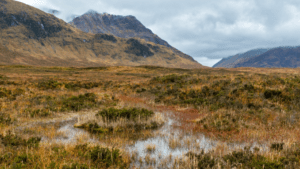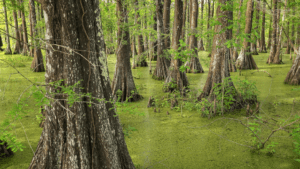
Introduction
A wetland is a place or area whose soil is seasonally or permanently moist. All over the world, there are different types of wetlands, such as marshes, fens, estuaries, mudflats, deltas, coral islands, swamps, bogs, etc. They are different from each other. Their features set them apart from each other. Among all these wetlands, the differences between the three types of wetlands Bog vs swamp vs marsh are discussed below.
Before discussing these three types of wetlands, let’s discuss a little about what wetlands are. Wetlands are degraded ecosystems where the water level is always at or near the surface. According to the Ramsar Convention – 1971, wetlands are defined as, “areas of marsh, fen, peatland or water, whether natural or artificial, permanent or temporary, with water that is static or flowing, fresh, brackish or salt including areas of marine waters, the depth of which at low-tide does not exceed six meters”.
Wetlands have many characteristics. The common features of all wetlands are the groundwater level is very close to the soil surface or that shallow water covers the surface for at least part of the year. Wetlands are known by many names such as swamps, peatlands, marshes, fens, potholes, bogs, etc. Scientists considered swamps, marshes, and bogs to be the three main types of wetlands (1) & (3).
Before discussing the difference between bog, swamp, and marsh, let’s see what they are.
What is a bog?

A bog is a soft wetland that consists mainly of decayed plant matter or dead plant materials (sphagnum mosses) which is known as peat.
Features
- It is one of the four main types of wetlands.
- Bog is a type of freshwater wetland.
- This type of wetland is mainly found in cold climates such as the northern part.
- Plants are not grown in bog wetlands, because these types of wetlands have very acidic water.
- Bogs receive water from precipitation like snow, rain, etc.
- Downstream flooding is prevented by these wetlands.
- It is mainly a type of wetland ecosystem.
- Basically, these wetlands are known as peatlands. It is dominated by sphagnum mosses.
Importance
- Bogs absorb large amounts of precipitation, so they are very important.
- They also prevent floods.
- These wetlands can provide a habitat for many mammals such as caribou, beavers, etc. (2).
What is a swamp?

The swamp is a forested wetland or a mineral soil wetland ecosystem that is permanently saturated or filled with water.
Features
- It is an ecotone that is characterized by mineral soils and plant life dominated by trees.
- Swamps are found all over the world. They are especially common in low-lying areas next to the rivers that provide swamps.
- Freshwater swamps and saltwater swamps are types.
- They are classified as forest and shrub swaps.
- Woody plants are shown in these wetlands.
- Both land and water play a role in creating this environment, so it is called the transition zone.
- A swamp in Florida, USA is one of the freshwater swamps.
Importance
- They prevent floods by absorbing excess water.
- These wetlands protect coastal areas from storms.
- They provide food and habitat for fish and many other species.
- It is a valuable source of fresh water and oxygen.
- Swamp water has many types of fish. So it is the most important resource for the production and distribution of fish (2).
What is a marsh?

A type of mineral soil wetlands that is continually full of water, is called marsh.
Features
- Marsh is a type of wetland ecotone that is characterized by mineral soils and by plant life dominated by grasses.
- These wetlands are found where extensive deltas are formed.
- Sometimes it is common at the mouth of the rivers.
- It is always covered with water.
- This type of wetlands is dominated by herbaceous plants, such as grasses, reeds, and sedges.
- They formed a transition between aquatic and terrestrial ecosystems.
Importance
- They act as a sink by filtering pollutants and sediments from the water which improves water quality.
- They also provide research services, tourism, etc.
- Marshes are able to absorb water during heavy rainfall, thereby reducing flooding.
- They have a high biological content that supports fisheries (2).
Bog vs Swamp vs Marsh
Bog, swamp, and marsh are both a type of swamp. So there are some similarities and differences between them. It is described with the help of a table below.
| Bog | Swamp | Marsh |
|
The swamp is a type of forest wetland that is dominated by trees. | Marsh is a type of wetland in which water covers the ground for a long time. |
|
Swamps are organic soil wetlands. | Marshes are organic soil wetlands. |
|
They are found in low-lying areas next to the river. | These wetlands are found where extensive deltas are formed. |
|
It is dominated by trees. | Marshes are dominated by different types of grasses. |
|
Swamp water is not acidic, so there are some trees found in swamp wetlands. | Marsh wetlands are also acid-free. So there are different types of grasses found here. |
|
They provide food and habitat for fish and many other species. | Marsh wetland acts as a sink by filtering pollutants and sediments from the water which improves water quality. |
|
Swamp wetlands are two types’ freshwater swamps and saltwater swamps. | Marshes are three types. These are saltwater marshes, freshwater tidal marshes, and freshwater marshes. |
|
Swamps are low wetlands. It often forms near forested areas. | Marshes also have low wetlands. It is located along shallower rivers and lakes. |
|
Woody plants are found in these wetlands. | Shrubs-type plants are found here. |
|
Soil is rich in minerals and different soils are found here such as sandy soil, clay soil, etc. Here soil pH level is neutral or alkaline. | The soil in marsh wetlands is nutrient-rich soil. That is marsh wetland soils have higher mineral content than swamps (1) & (3). |
Similarities
- Both are types of wetlands.
- All these wetlands can prevent floods by absorbing excess water.
- There are different types of animals present in both wetlands’ water.
Q&A
1. Swamp vs bog vs marsh?
- Swamps are forested wetlands that are dominated by woody plants. It is found in floodplains of rivers. The soil of these wetlands is muddy and mucky.
- Bogs are spongy, peat-based organic soil wetlands. It is found in cold and damp regions. The water here is acidic and the soil nutrient amount is lower than a swamp.
- Marsh is a type of wetland that is found where extensive deltas are formed and dominated by grasses.
2. Swamp vs marsh vs bog vs fen
- Grasses, reeds, sedges, and other herbaceous plants are found in swamps.
- Bogs are organic soil wetlands mainly found in cold climates. They are dominated by mosses.
- Marshes are mineral soil wetlands found near the mouths of the rivers.
- Fen is a type of organic soil wetland ecosystem that is dominated by grass plants.
3. Difference between swamp marsh bog fens
The differences between swamp, bog, marsh, and fen are
- Swamp water can be fresh, brackish, or saline. The woody plants found here. This type of wetlands can be of different shapes. They provide food and habitat for fish and many other species. It is a valuable source of fresh water and oxygen.
- Bog is a type of freshwater wetland. This type of wetland is mainly found in cold climates. The water in the bog is acidic and low in nutrients. Bog has fresh water. More than 30 cm thick peat is usually present here. They act as a carbon sink.
- Marshes are mineral soil wetlands that are found in the mouth of the river. They are dominated by different types of grass. The water can be fresh or salt.
- Fen is a type of organic soil wetland that is dominated by grass. The water in a fen is alkaline and rich in nutrients.
4. Difference between bog swamp and marsh
| Bog | Swamp | Marsh |
|
The swamp is a type of wetland that is dominated by woody plants. | Marsh is a type of wetland, Dominated by grass. |
|
Swamp Soil is rich in minerals and different soils found here such as sandy soil, and clay soil. | Marsh wetland soil is nutrient-rich soil. |
|
This wetland provides food and habitat for fish and many other species | It acts as a sink by filtering pollutants and sediments from the water. |
|
There are two types such as freshwater swamps and saltwater swamps. | There are three types of marshes, these are saltwater marshes, freshwater tidal marshes, and freshwater marshes |
|
Swamps are low wetlands. | Marshes are lower wetlands than swamps. |
Closing summary
- Bogs are mainly organic soil wetlands.
- They formed where the groundwater is acidic and low in nutrients.
- These wetlands formed in poorly draining lake basins.
- The gradual collection of decaying plants in bogs plays an important role. They act as a carbon sink.
- A raised bog in the Kemeri National Park, Jurmala, Latvia, was created during the postglacial period about 10,000 years ago and is now a tourist attraction.
- Precipitation like rain, snow, hail, etc. accumulates in the bog to form a bog pool. Koitjarve bog in Estonia is an example of this type of bog pool.
- Swamp wetlands can be of different shapes.
- Freshwater swamps form along large rivers or lakes where they are dependent on natural water levels.
- Saltwater swamps develop along tropical and subtropical coastlines.
- World’s largest swamps are found along major rivers such as the Amazon, Mississippi, and Congo.
- Sources of water accumulated in swamps are precipitation, groundwater, tidal, freshwater, and floods.
- Swamps provide ecological services including flood control, fish production, water purification, carbon storage, and wildlife habitat.
- Plants present in such wetlands have rhizomes for underground storage and reproduction.
- There are three types of marshes, these are saltwater marshes, freshwater tidal marshes, and freshwater marshes. And each wetland is home to different organisms.
- The Okavango marsh that is present east of the Kalahari Desert in Botswana is an example of the marsh.
- Such wetlands are home to a variety of invertebrates, amphibians, etc.
- Saltwater marshes are found in mid to high latitudes around the world.
- Marsh acts as a sink by filtering pollutants and sediments from the water. So the water is free of pollutants and sediments (3).
Written By: Manisha Bharati
